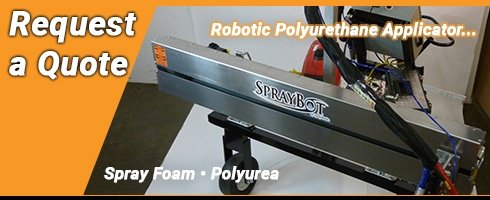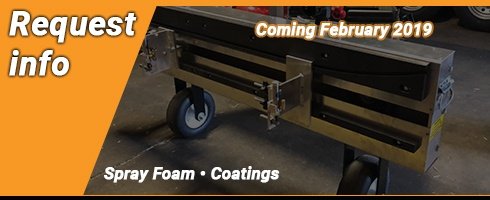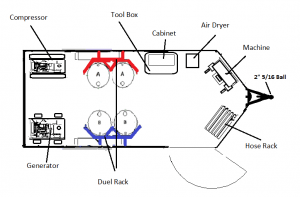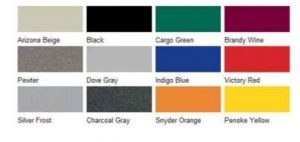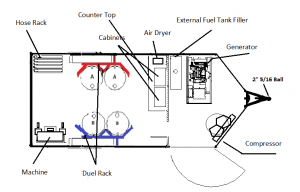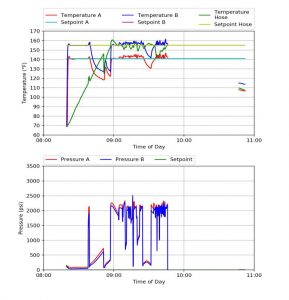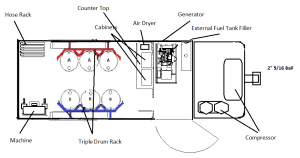If you operate a business that utilizes spray foam, or you are adding this service to your company’s services, you have likely considered adding a foam rig. A spray foam rig will be your one central location for storing all of your spray foam needs including but not limited to; a reactor, generator, transfer pumps, hoses, material, and air compressor.
We carry multiple types of rigs including; easy-transport portable rigs and high production rigs for big projects, as well as smart rigs, economy rig sets for budget-conscious business owners, and highly customized rigs for bigger projects or projects that require a spray foam machine and polyurea machine. Selecting the right rig for your business depends on certain factors including the intended use of the rig, what types of coatings you offer to customers, psi rating for high or low-pressure systems, and the type of trailer you plan on using. Here are some things to consider when deciding what spray foam trailer to get for your rig. Choosing the right trailer is the first step in proper rig setup for your business.
Identifying Equipment Needed And GVWR Of The Trailer
The first component of identifying the type of trailer needed is to evaluate the scope of the services your business offers, the type of equipment you will be required to include in your rig, how much material you plan to transport, and how much weight will be required for transport. More importantly, you will need to know the towing capacity that the vehicle that will be pulling the rig can safely handle.
Every vehicle has a particular rating associated with the maximum capacity of weight it can handle towing. This rating is known as the Gross Vehicle Weight Rating (GVWR), and it can represent either the vehicle’s weight capacity or a trailer’s. The GVWR is determined by the trailer manufacturer, so the sum total of your spray foam rig equipment and material must be less than the trailer’s GVWR for safe transport.
Deciding Trailer Length
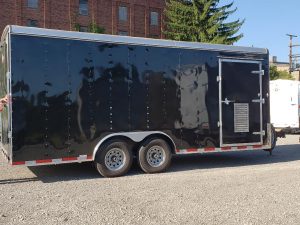
Our trailers range from 16 feet to 30 feet long. The length of rig required for your needs depends on the type of equipment you carry and how much of it you need, as well as the GVWR of your vehicle to ensure safe towing capacity. If you’re spraying one or two sets of material per day, you need less for length than if you spray six to 10 sets per day or operate with coatings and spray foam together.
You should also consider the areas this trailer will need to be towed. Spray foam trailers used in large and busy urban areas are typically tough to maneuver, regardless of length, but a longer trailer proves to be far more challenging, especially around sharp turns and in congested streets.
Types Of Trailers
Not all trailers are created equal and some are more convenient for particular geographical transport than others, while others are more suited to the positioning requirements of the spray foam equipment inside. The following are the most common trailer types available:
- V-Nose Trailer: With the front of the trailer shaped in a V-shape, these trailers are more aerodynamic, making them somewhat easier to haul. Of course, the V end does result in slightly less room for equipment inside, especially inside of busy spray foam rigs.
- Gooseneck Trailer: Rather than simply being attached to the vehicle’s hitch, a gooseneck trailer still sits on the towing part of a truck, but is characterized by a long “neck” portion that positions on top of the back of the tailgate. This promotes increased stability, offers a better load transfer when properly loaded (up to 25%), increased maneuverability on turns and reverse motions, and its adaptability to 5th wheel connections.
- 5th Wheel Trailer: This type of trailer is similar to the gooseneck trailer, except for its attachment to the towing vehicle by a secure kingpin or jaws installed on the truck bed. This allows for a more smooth pull of the vehicle with increased maneuverability and control.
- Box Trucks: This is a standard extended rectangular truck that can transport spray foam equipment rather than a trailer hitch. These are typically equipped with ramps to move equipment in and out or hydraulic platforms to allow easy maneuverability of equipment and heavy drums filled with material.
Types Of Doors
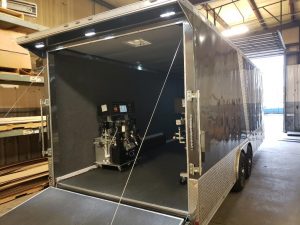
Another important consideration is the trailer doors which must be easily accessible, operable, and convenient for withdrawing your equipment, as well as restoring it back in place. There are three traditional door types on trailers. They include:
- Barn Door: These are doors that swing open to two opposing sides of the back of the trailer or truck. They allow for maximum net cargo area so they are best suited for those needing to move large equipment with ease.
- Ramp Door: Some trailers and rigs have a door that descends down to form a ramp. While this makes for a simple way to enter the rig to move equipment and material, ramps can become difficult in icy weather. However, as long as your ramp is properly stored, weather should not become an issue.
- Lift Gate: This type of doorway is typically latched at the bottom during transport, but when ajar, it moves up to the top of the truck rolling along the wheeled treads on the sides with just the push of a button. This gets the opening unobstructed for loading and unloading the spray foam rig.
Other Things To Consider
Do I Need A Special Driver’s License?
Whether you need a special license to operate a rig depends on the total weight. For instance, box trailers can be operated with a standard driver’s license, but many hitched trailers require a special driver’s license due to the special skills needed to master their maneuverability and safe operation of the hitch attachment. The rig’s GVWR is a big factor in the licensing requirements, as well as the state in which the rig is operated. As a general rule, most states require some type of special license to operate a trailer rig that is at 10,000 pounds of GVWR.
How High Should The Ceiling Be?
While there are no particular federal requirements for ceiling heights in rigs, they typically come sized at around 8 feet. States can set their own height restriction, however, mostly dictated by the presence of low underpasses on certain roads as these can sometimes be too low for a rig to pass under without getting stuck. This height however is typically more than sufficient for every road in the US and is adequate in height to allow the equipment to be stored and the driver to enter and maneuver inside with ease. Its best to have a ceiling too high than one too low.
Conclusion
If you are looking for a rig, we recommend making a list of the projects you plan to work on and the must-have’s for your rig. Give our expert rig builders a call today choose the best rig for your business (330)587-4141 or request a quote here.

